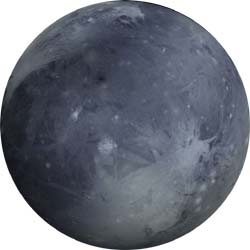|
|
Dwarf Planets

Artists impression of the distant dwarf planet Eris and its moon Dysnomia
Dwarf Planet Facts
- The dwarf planets are Ceres, Pluto, Eris, Makemake and Haumea.
- Ceres is in the asteroid belt, a region of rocky bodies between the orbits of Mars and Jupiter.
- Pluto, Eris, Makemake and Haumea orbit in the Kuiper Belt, a region of icy bodies 2.8 billion miles (4.5 billion km) from the sun. These objects are also classified as Plutoids.
- The largest dwarf planet is Eris which is around two thirds the size of our moon.
- At its furthest point Eris orbits the sun at a distance of 14 billion km and takes 557 years to make one orbit.
- The smallest dwarf planet Ceres was previously classified as an asteroid, it is around a quarter of the size of our moon.
- A cluster of bright spots on the surface of Ceres are believed to be light reflecting of deposits of ice.
- The dwarf planet Pluto has a very thin atmosphere consisting of nitrogen, methane and carbon dioxide.
- The largest moon of Pluto, Charon, is half the size of the former planet.
- Eris, Makemake and Haumea were discovered between 2003-2005.
When is a planet not a planet?

The dwarf planet Makemake orbits in the Kuiper Belt
Pluto Facts

Artists impression of Pluto's frozen surface
Missions to Dwarf Planets
Dawn
 Launch: September 2007
Launch: September 2007Arrival: March 2015
Agency: NASA
Summary: Dawn completed the first part of its mission which was to study the large asteroid Vesta. It successfully entered into orbit around the asteroid in July 2011 before leaving in September 2012. In March 2015 the craft successfully entered into orbit around Ceres and began analyzing and imaging the dwarf planet's surface in late April. Dawn has been the first craft to successfully enter into orbit around two separate bodies, this is thanks to the crafts ion propulsion engine (pictured left), which is more fuel efficient than a conventional chemical rocket allowing it to make more maneuvers and run for longer. The goal of the mission is to characterize the early solar system and determine how size and the presence of water influenced the evolution of planets.
New Horizons
 Launch: January 2006
Launch: January 2006Arrival: July 2015
Agency: NASA
Summary: NASA launched New Horizons in January 2006 thus taking advantage of a once in a life time chance to use Jupiter as a gravity assist towards Pluto. It should arrive at Pluto in July 2015 thus becoming the first spacecraft ever to visit the planet. New Horizons will make a flyby of the dwarf planet at a distance of 6,000 miles (9,600 km) and its moon Charon at a distance of 17,000 miles (27,000 km).

Pluto Statistics
Diameter: 1,429 miles (2,300 km)Average Distance from Sun: 3.6 billion miles (5.9 billion km)
Orbital Period: 248 years
Rotation Period: 6.39 days
Moons: 5
Maximum Surface Temperatures: -218C (-360F)
Minimum Surface Temperatures: -240C (-400F)
Mass: 0.22% Earth's Mass
Density: 40% Earth's Density
Atmosphere: Nitrogen, methane, carbon dioxide. Discovery Date: 1930

Ceres Statistics
Diameter: 590 miles (950 km)Average Distance from Sun: 257 million miles (414 million km)
Orbital Period: 4.6 years
Rotation Period: 9 hours
Moons: 0
Maximum Surface Temperatures: -37C (-35F)
Minimum Surface Temperatures: -143C (-225F)
Mass: 0.015% Earth's Mass
Density: 38% Earth's Density
Atmosphere: Unknown. Discovery Date: 1801

Eris Statistics
Diameter: 1,442 miles (2,320 km)Average Distance from Sun: 6.3 billion miles (10.2 billion km)
Orbital Period: 557 years
Rotation Period: 26 hours
Moons: 1
Maximum Surface Temperatures: -217C (-359F)
Minimum Surface Temperatures: -240C (-405F)
Mass: 0.28% Earth's Mass
Density: 46% Earth's Density
Atmosphere: Tenuous atmosphere consisting of methane. Discovery Date: 2005
Share this page
Related Pages